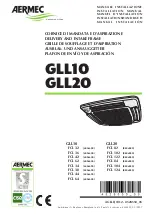
4
English
Installation
•
Do not use the air conditioner in environments with
hazardous substances or close to equipment that
release free flames to avoid the occurrence of fires,
explosions or injuries.
•
Our units must be installed in compliance with the
spaces indicated in the installation manual to ensure
either accessibility from both sides or ability to
perform routine maintenance and repairs. The units’
components must be accessible and that can be
disassembled in conditions of complete safety either
for people or things. For this reason, where it is not
observed as indicated into the Installation Manual,
the cost necessary to reach and repair the unit (in
safety, as required by current regulations in force)
with slings, trucks, scaffolding or any other means of
elevation won’t be considered in-warranty and will
be charged to end user.
•
The outdoor unit shall be installed in an open space
that is always ventilated.
•
The local gas regulations shall be observed.
•
To handle, purge, and dispose the refrigerant, or
break into the refrigerant circuit, the worker should
have a certificate from an industry-accredited
authority.
•
Do not install the indoor unit in the following areas:
–
Area filled with minerals, splashed oil, or
steam. It will deteriorate plastic parts, causing
failure or leakage.
–
Area that is close to heat sources.
–
Area that produces substances such as sulfuric
gas, chlorine gas, acid, and alkali. It may cause
corrosion of the pipings and brazed joints.
–
Area that can cause leakage of combustible
gas and suspension of carbon fibers,
flammable dust, or volatile flammables.
–
Area where refrigerant leaks and settles.
–
Area where animals may urinate on the
product. Ammonia may be generated.
•
Do not use the indoor unit for preservation of food
items, plants, equipment, and art works. This may
cause deterioration of their quality.
•
Do not install the indoor unit if it has any drainage
problem.
•
When installing the outdoor unit at the seaside,
make sure that it is not directly exposed to sea
breeze. If you cannot find an adequate place free
from direct sea breeze, construct a protection wall or
a protective fence.
–
Install the outdoor unit in a place (such as
near buildings etc.) where it can be protected
from sea breeze. Failure to do so may cause a
damage to the outdoor unit.
Sea
Sea breeze
Outdoor unit
Outdoor unit
Sea breeze
Sea
•
If you cannot avoid installing the outdoor unit at the
seaside, construct a protection wall around to block
the sea breeze.
•
Construct a protection wall with a solid material
such as concrete to block the sea breeze. Make sure
that the height and the width of the wall are 1.5
times larger than the size of the outdoor unit. Also,
secure a space larger than 600 mm between the
protection wall and the outdoor unit for exhausted
air to ventilate.
Sea
Sea breeze
Outdoor unit
Protection wall
Outdoor unit
Protection wall
•
Install the unit in a place where water can drain
smoothly.
•
If you have any difficulty finding installation location
as prescribed above, contact your manufacturer for
details.
•
Be sure to clean the sea water and the dust on the
heat exchanger of the outdoor unit and apply a
corrosion inhibitor on it. (At least once in a year.)
•
For the multi system, this indoor unit can be
conncected to an R-32 or R-410A outdoor unit. Check
the type of refrigerant in the outdoor unit.
•
In addition to table 1, make sure that the indoor and
outdoor unit are installed in a space at least of 4m²
to guarantee the regular maintenance or service
repair.
Содержание AR**MXPD Series
Страница 30: ...DB68 06730A 03 ...





































